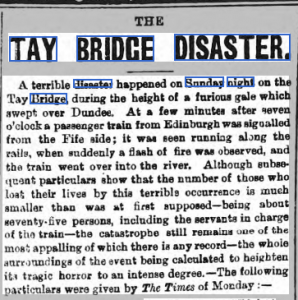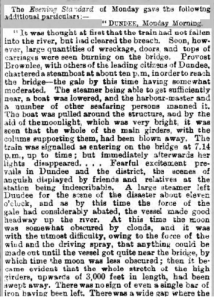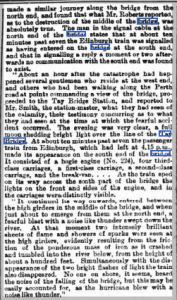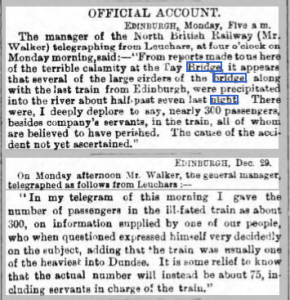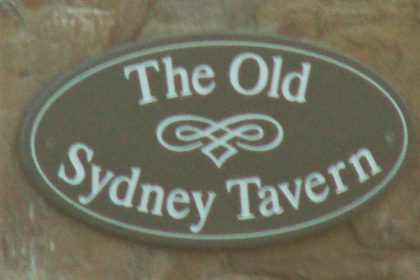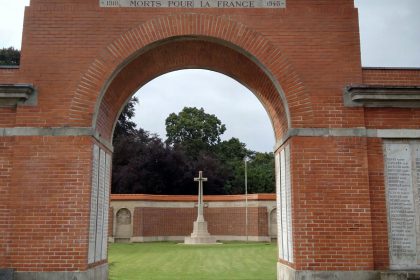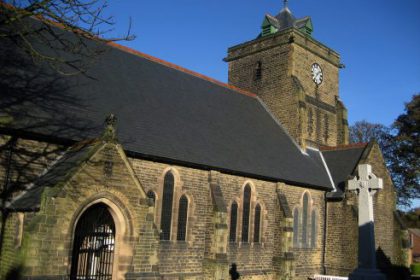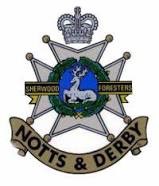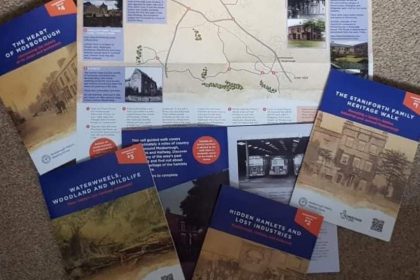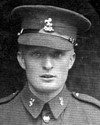A terrible disaster happened Sunday night on the Bridge, daring the height a furious gale which swept over Dundee. At a few minutes after seven o’clock passenger train from Edinburgh signalled from the Fife side; it was seen running along the rails, when suddenly a dash of fire was observed, and the train went over into the river. Although subsequent particulars show that the number of those who lost their lives by this terrible occurrence is much smaller than was at first supposed—being about seventy-five persons, including the servants in charge of the train, the catastrophe still remains one of the most appalling of which there is any record of the whole surroundings of the event being calculated to heighten its tragic horror to an intense degree. The following particulars were given by The Times of Monday :-
Dundee, Sunday, Midnight.
Tonig
ht heavy gale swept over Dundee, and a portion of the Tay-bridge was blown while the Sci-.in from Edinburgh due at 7.15 was passing, It is believed that the train is in the water, but the gale is strong that a steamboat has not yet been able to reach the bridge. The train was duly signalled from the Fife side as having entered on the bridge for Dundee at 7.14. It seen running along the rails, and then suddenly there was observed a flash of fire. The opinion was that the train left the rails and went over the bridge. Those who saw the incident repaired immediately to the Tay-bridge Station at Dundee and informed the stationmaster of what they had seen. He immediately put himself in communication with the man in at charge of the signal-box the north end of the bridge. The telegraph wires are stretched across the bridge, but when the instrument was tried it; was soon seen that the wires were broken.
Mr Smith, the stationmaster, and Mr. Roberts, locomotive superintendent, determined, notwithstanding the fierce gale, to walk across the bridge as far as possible from the north side, with the view ascertaining the extent of the disaster. They were able to get out a considerable distance, and the first thine that caught their eye was the water spurting from a pipe which was laid across the bridge for the supply of Newport, a village on the south side, from the Dundee reservoirs. Going out a little further, they could distinctly sea by the aid of the strong moonlight that there was a large gap in the bridge caused the fall, so far as they could discern, two or three of the largest spars. They thought, however, that they observed a red light on the south part the bridge and were of the opinion that the train bad been brought to standstill on the driver noticing the accident. This conjecture has, unfortunately, proved incorrect. Broughty ferry, four miles from the bridge, several mail bags have come ashore, and there now no doubt that the train is in toe river. precise information the number of passengers in the train can be obtained, but it is variously estimated at from 150 to 200.
Edinburgh, Monday. 1 am
The news of the appalling accident reached Edinburgh about nine p.m. It came in the first Instance to Mr. Paton, the stationmaster of the North British Line, and some time naturally elapsed before the tidings were made public. The first report was simply that a portion of the bridge had given way before violent hurricane. Later despatches added the more terrible fact that a passenger train had been engulphed in the Tay, and that it was to be feared none of those whom it conveyed had escaped.
Of the gale in Edinburgh it may be said that It was exceptional violence, blowing chiefly in a S.W. direction. It came in fearful squalls, driving the rain before it in blinding clouds. It began Saturday morning, and raged all day and night, subsiding in the course the morning. Sunday forenoon was fine, mild, calm, and seasonable, bat in the afternoon the storm again burst with redoubled violence, and it was at Its height that the dreadful disaster seems have occurred.
Whether the girders were blown down first or train the carried them away when it was blown over, cannot be ascertained, and will doubtless remain mystery, for one in the train has been saved. Immediately after the disaster quantities of wreckage and clothing and half a dozen London mail bags for Dundee and Aberdeen drifted ashore, and by nine o’clock all the beach was strewn with remains of broken carriages and pieces of the bridge.
The Evening Standard of Monday gave the following additional particulars: Dundee, Monday Morning.
It was thought at first that the train had not fallen into the river but had cleared the breach. Soon, however, large quantities of wreckage, doors, and tops of carriages were seen burning on the bridge, Provost Brownlee, with others the leading citizens Dundee, chartered a steamboat at about ten pm, in order to reach the bridge, the gale by this time having somewhat moderated, The steamer being able to get sufficiently near a boat was lowered, and the harbour-master and number of other seafaring persons manned it. The boat was pulled around the structure, and by the aid the moonlight, which was very bright, it was seen that the whole of the main girders, with the columns supporting them, had been blown away. The train was signalled entering on the bridge at 7.14 p.m., up to time; but Immediately afterwards her lights disappeared. . . . Fearful excitement prevails in Dundee and the district, the scenes of anguish displayed by friends and relatives the station being indescribable. A large steamer left Dundee for the scene of the disaster about eleven o’clock, and as by this time the force of the gale bad considerably abated, the vessel made good headway up the river. At this time the moon was somewhat obscured by clouds, and it was with the utmost difficulty, owing to the force of the wind and the driving spray, that anything could be made out until the vessel got quite near the bridge, by which time the moon was less obscured; then it became evident that the whole stretch of the high girders, upwards of 3,000 feet in length, had been swept away. There was no sign of even a single bar of iron having been left.
There was a wide gap where the high girders, the most conspicuous feature of the great bridge, spanned the channel The astonishing thing is the tail such an enormous mass of iron was not heard in the town ; but it would appear that nothing was heard beyond the roar of the gale even by persons who were on the watch for the crossing of the train the Dundee end of the bridge. This in Itself is a proof the violence of the gale. As the steamer neared the bridge, what appeared to be broken water was observed stretching across the river, marking, it was presumed, the submerged girders and train. It was seen that it would hazardous to approach too near the wreck, and boat was lowered from the steamer and was immediately manned by a bold crew. The boat was pulled as close the bridge as was deemed safe, and then her head was turned towards the north shore. She was pulled across the whole open space to the first pier, then through between the piers and back again along the west side till the standing piers on the south side were reached. The task was a difficult and hazardous one. When the vessel returned Dundee, about one o’clock this morning, her passengers were eagerly questioned by hundred persons who had anxiously waited for their return. When it was stated that no additional information could be furnished, some heart-rending scenes occurred.
“It was about half-past seven o’clock when a rumour of the catastrophe spread through Dundee. As the report passed from mouth to mouth, it was thought incredible, and people reminded one another that the bridge, since its completion, had withstood many terrific blasts. The news, however, was so appalling, that although it was generally received with reservation, everyone who heard it made off once with bated breath the Magdalen-yard Point, or the Tay Bridge Station, with the view of ascertaining what foundation there might be for it. In the course of a very short time those in quest of information could b« foamed by hundreds at the Bridge Station. However, the officials were unable to give any information beyond the fact that since a few minutes after seven o’clock communication between the signal cabins at each end the bridge had been cut From the station inquirers proceeded by the Perth road to the Esplanade, to Magdalen-yard Point, where the north signal cabin is situated, order to pick whatever particle of information could there be found. good many persons entered the cabin and inquired of the signalman as the calamity, He could throw no further light on the matter. The railway officials, who had naturally become alarmed, especially since they became aware that there was no communication with the south end of the bridge, resolved satisfy themselves whether the structure was safe or not. Accordingly, Mr. Roberts, superintendent of the locomotive department, went along the bridge. This he did at considerable risk, for the force of the hurricane was still such that times he was almost completely lifted off his feet and was in great danger of being blown into the river. Urged, however, by anxiety to learn the truth, he persevered in his perilous task; and having walked along bridge as far could, crawled on his hands and knees to the point where the high girders began. Here his course was arrested. Horror-stricken, he found that the rumour in circulation was too true.
“The
whole of the 13 girders, each 245 ft, in length and 250 tons in weight, which, as it were, had formed a tunnel in the middle of the bridge, were gone, and remained but the bare iron piers which had them.
Mr. Smith, the stationmaster, also made a similar journey along the bridge from the north end, and found that what Mr. Roberts reported, as to
the destruction of the middle of the bridge, was absolutely true. The man in the signal cabin at the north end of the bridge states that at about ten minutes past seven the Edinburgh train was signalled as having entered on the bridge at the south end, and that in signalling reply moment or two afterwards no communication with the south end was found exist.
“About an hour after the catastrophe had happened several gentlemen who reside at the west end, and others who had been walking along the Perth road at points commanding view of the bridge, proceeded to the Bridge Station, and reported to Mr. Smith, the station-master, what they bad teen of the calamity, their testimony concurring as what they had seen at the time which the fearful accident occurred. The evening was very clear, a full moon shedding bright light over the line of the Tay Bridge. At about ten minutes past seven the passenger train from Edinburgh, which had left at 4.15 p.m., which made its appearance on the south end of the bridge. It consisted of a bogie engine (No. 224), four third class carriages, a first-class carriage, second-class carriage, and the break-van. … As the train sped its way across the south part of the bridge the lights on the front and sides of the engine, and in the carriages were distinctly visible.
“It continued Its way onwards, entered between the high girders in the middle of the bridge, and when just about to emerge from them at the north end, and a fearful blast with a noise like thunder swept down the river. At that moment two intensely brilliant sheets of flame and showers of sparks were seen at the high girders, evidently resulting from the friction of the ponderous mass of iron as it crashed and tumbled into the river below, from the height of about a hundred feet.
Simultaneously with the disappearance of the two bright flashes of light the train also disappeared, No one on shore, it seems, heard the noise of the falling of the bridge, but this may be easily accounted for, the hurricane blew with a noise like thunder.
OFFICIAL ACCOUNT. Edinburgh, Monday, Five am.
The manager of the North British Railway (Mr. Walker) telegraphing from Leuchars, at four o’clock on Monday morning, said:—“From reports made to us here of the terrible calamity at the Tay Bridge, it appears that several of the large girders of the bridge, along with the last train from Edinburgh, were precipitated into the river about half-past seven last night. There were, I deeply deplore to say, nearly 300 passengers, besides company’s servants, in the train, all of whom are believed to have perished. The cause of the accident not yet ascertained.”
Edinburgh, Dec. 29.
On Monday afternoon Mr. Walker, the general manager, telegraphed as follows from Leuchars: –
“In my telegram of this morning I gave the number passengers in the ill-fated train as about 300, on information supplied by one our people, who when questioned expressed himself very decidedly on the subject, adding that ‘he train was usually one of the heaviest into Dundee. It is some relief know that the actual number will instead be about 75, including servants in charge of the train.”
Bury Free Press – Saturday 03 January 1880 © BNA The Tay Bridge Diaster W LEE’s Diary

